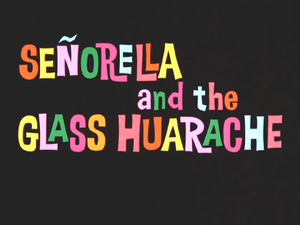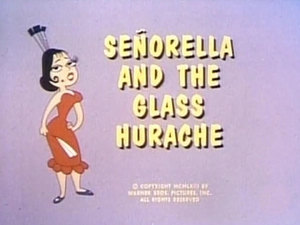Señorella and the Glass Huarache
From Looney Tunes Wiki
Jump to navigationJump to search
| Señorella and the Glass Huarache | |
|---|---|
| Production company | Warner Bros. Cartoons |
| Distributor | Warner Bros. Pictures |
| Release date | August 1, 1964 |
| Starring | Mel Blanc Tom Holland |
| Producer(s) | David H. DePatie |
| Music composition | Bill Lava |
| Story | John Dunn |
| Animation | Gerry Chiniquy Bob Matz Virgil Ross Lee Halpern |
| Director(s) | Hawley Pratt |
| Series navigation | |
| ← Previous | Next → |
| Title card | |

| |
| Second title card | |

| |
Señorella and the Glass Huarache is the four hundred and forty-second Looney Tunes theatrical short. It was distributed by Warner Bros. Pictures on August 1, 1964. It was written by John Dunn, produced by David H. DePatie, and directed by Hawley Pratt.
Tired of her slavish living under her wicked "strapmother" and "strapsisters", a young woman named Señorella wishes to go on a fiesta at the estate of a bullfighter's father.
Detailed summary
Memorable quotes
Man: It was not sad. It was a happy story. But what happened to the strapmother?
Storyteller: Ah, that's the sad part. I marry her.
Characters
In order of appearance: | ||||||||||||||
| ||||||||||||||
Locations
Objects
- Glass huarache
Vehicles
- Car with "mucho married" sign
Production
Development
Filming
Music
The music was composed by Bill Lava.
Crew credits
- Layouts: Hawley Pratt
- Backgrounds: Tom O'Loughlin
- Effects Animation: Harry Love
- Film Editor: Treg Brown
Release
Dates are in order of release:
- United States: August 1, 1964 in theatres
Behind the scenes
- The MPAA certificate number is 197733
- The short's plot is a Mexican retelling of the Cinderella fairy tale.
- The opening and closing titles are reused from Now Hear This and Bartholomew Versus the Wheel.
- It rarely airs on U.S. television due to its heavy stereotyping on Mexicans.
Legacy
- The short was the final theatrical release of the Looney Tunes series before the shutdown of the Warner Bros. Cartoons division, although it was not the last one produced, as it would go to False Hare, which was released about a month prior.
- Starting in 1965, the abstracted intro and outro sequences would be used for the rest of the series.
Errors
- On the short's title card used for The Merrie Melodies Show, the word "Huarache" is spelled wrong.
Critical reception
Home availability
- United States